I do not know if my answer is perfectly relevant to the question you put, but hereafter I propose my C version of the Flood-Fill algorithm, which does not use recursive calls.
1-11-2017: NEW-VERSION; SUCCESFULLY TESTED WITH TWO BITMAPS.
It uses only a queue of the offsets of the new points, it works on the window: WinnOffs-(WinDimX,WinDimY) of the double-buffer: *VBuffer (copy of the screen or image) and, optionally, it write a mask of the flood-fill's result (*ExtraVBuff).
ExtraVBuff must be filled it with 0 before the call (if you don't need a mask you may set ExtraVBuff= NULL); using it after call you can do gradient floodfill or other painting effects. NewFloodFill works with 32 Bit per Pixel and it is a C function. I've reinvented this algorithm in 1991 (I wrote his in Pascal), but now it works in C with 32 Bit per Pixel; also not uses any functions calls, does only a division after each "pop" from queue, and never overflows the queue, that, if it is sized in the right way (about 1/4 of the pixels of the image), it allows always to fill correctly any area; I show before the c-function (FFILL.C), after the test program (TEST.C):
#define IMAGE_WIDTH 1024
#define IMAGE_HEIGHT 768
#define IMAGE_SIZE IMAGE_WIDTH*IMAGE_HEIGHT
#define QUEUE_MAX IMAGE_SIZE/4
typedef int T_Queue[QUEUE_MAX];
typedef int T_Image[IMAGE_SIZE];
void NewFloodFill(int X,
int Y,
int Color,
int BuffDimX,
int WinOffS,
int WinDimX,
int WinDimY,
T_Image VBuffer,
T_Image ExtraVBuff,
T_Queue MyQueue)
/* Replaces all pixels adjacent to the first pixel and equal to this; */
/* if ExtraVBuff == NULL writes to *VBuffer (eg BUFFER of 786432 Pixel),*/
/* otherwise prepare a mask by writing on *ExtraVBuff (such BUFFER must */
/* always have the same size as *VBuffer (it must be initialized to 0)).*/
/* X,Y: Point coordinates' of origin of the flood-fill. */
/* WinOffS: Writing start offset on *VBuffer and *ExtraVBuff. */
/* BuffDimX: Width, in number of Pixel (int), of each buffer. */
/* WinDimX: Width, in number of Pixel (int), of the window. */
/* Color: New color that replace all_Pixel == origin's_point. */
/* WinDimY: Height, in number of Pixel (int), of the window. */
/* VBuffer: Pointer to the primary buffer. */
/* ExtraVBuff: Pointer to the mask buffer (can be = NULL). */
/* MyQueue: Pointer to the queue, containing the new-points' offsets*/
{
int VBuffCurrOffs=WinOffS+X+Y*BuffDimX;
int PixelIn=VBuffer[VBuffCurrOffs];
int QueuePnt=0;
int *TempAddr=((ExtraVBuff) ? ExtraVBuff : VBuffer);
int TempOffs1;
int TempX1;
int TempX2;
char FLAG;
if (0<=X && X<WinDimX && 0<=Y && Y<WinDimY) do
{
/* Fill to left the current line */
TempX2=X;
while (X>=0 && PixelIn==VBuffer[VBuffCurrOffs])
{
TempAddr[VBuffCurrOffs--]=Color;
--X;
}
TempOffs1=VBuffCurrOffs+1;
TempX1=X+1;
/* Fill to right the current line */
VBuffCurrOffs+=TempX2-X;
X=TempX2;
while (X+1<WinDimX && PixelIn==VBuffer[VBuffCurrOffs+1])
{
++X;
TempAddr[++VBuffCurrOffs]=Color;
}
TempX2=X;
/* Backward scan of the previous line; puts new points offset in Queue[] */
if (Y>0)
{
FLAG=1;
VBuffCurrOffs-=BuffDimX;
while (X-->=TempX1)
{
if (PixelIn!=VBuffer[VBuffCurrOffs] ||
ExtraVBuff && Color==ExtraVBuff[VBuffCurrOffs])
FLAG=1;
else
if (FLAG)
{
FLAG=0;
if (QueuePnt<QUEUE_MAX)
MyQueue[QueuePnt++]=VBuffCurrOffs;
}
--VBuffCurrOffs;
}
}
/* Forward scan of the next line; puts new points offset in Queue[] */
if (Y<WinDimY-1)
{
FLAG=1;
VBuffCurrOffs=TempOffs1+BuffDimX;
X=TempX1;
while (X++<=TempX2)
{
if (PixelIn!=VBuffer[VBuffCurrOffs] ||
ExtraVBuff && Color==ExtraVBuff[VBuffCurrOffs])
FLAG=1;
else
if (FLAG)
{
FLAG=0;
if (QueuePnt<QUEUE_MAX)
MyQueue[QueuePnt++]=VBuffCurrOffs;
}
++VBuffCurrOffs;
}
}
/* Gets a new point offset from Queue[] */
if (--QueuePnt>=0)
{
VBuffCurrOffs=MyQueue[QueuePnt];
TempOffs1=VBuffCurrOffs-WinOffS;
X=TempOffs1%BuffDimX;
Y=TempOffs1/BuffDimX;
}
/* Repeat the main cycle until the Queue[] is not empty */
} while (QueuePnt>=0);
}
Here there is the test program:
#include <stdio.h>
#include <malloc.h>
#include "ffill.c"
#define RED_COL 0xFFFF0000
#define WIN_LEFT 52
#define WIN_TOP 48
#define WIN_WIDTH 920
#define WIN_HEIGHT 672
#define START_LEFT 0
#define START_TOP 671
#define BMP_HEADER_SIZE 54
typedef char T_Image_Header[BMP_HEADER_SIZE];
void main(void)
{
T_Image_Header bmpheader;
T_Image *image;
T_Image *mask;
T_Queue *MyQueue;
FILE *stream;
char *filename1="ffill1.bmp";
char *filename2="ffill2.bmp";
char *filename3="ffill3.bmp";
int bwritten;
int bread;
image=malloc(sizeof(*image));
mask=malloc(sizeof(*mask));
MyQueue=malloc(sizeof(*MyQueue));
stream=fopen(filename1,"rb");
bread=fread(&bmpheader, 1, BMP_HEADER_SIZE, stream);
bread=fread((char *)image, 1, IMAGE_SIZE<<2, stream);
fclose(stream);
memset(mask,0,IMAGE_SIZE<<2);
NewFloodFill(START_LEFT,
START_TOP,
RED_COL,
IMAGE_WIDTH,
IMAGE_WIDTH*WIN_TOP+WIN_LEFT,
WIN_WIDTH,
WIN_HEIGHT,
*image,
NULL,
*MyQueue);
stream=fopen(filename2,"wb+");
bwritten=fwrite(&bmpheader, 1, BMP_HEADER_SIZE, stream);
bwritten=fwrite((char *)image, 1, IMAGE_SIZE<<2, stream);
fclose(stream);
stream=fopen(filename3,"wb+");
bwritten=fwrite(&bmpheader, 1, BMP_HEADER_SIZE, stream);
bwritten=fwrite((char *)mask, 1, IMAGE_SIZE<<2, stream);
fclose(stream);
free(MyQueue);
free(mask);
free(image);
}
I've used, for the input of the test program shown, the follow Windows uncompressed .BMP image (ffill1.bmp):

Filled, by the test program shown, as follows (ffill2.bmp):

Using "mask" instead of NULL, the output bitmap is (ffill3.bmp):



